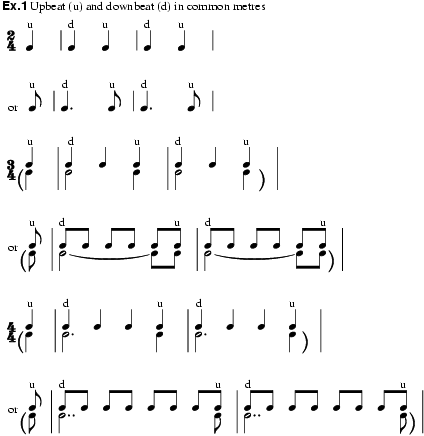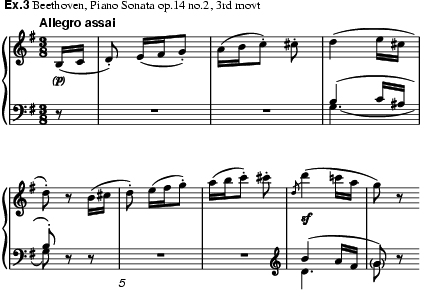
(Ger. Auftakt, Vortakt).
In a measured Rhythm, that impulse that immediately precedes, and hence anticipates, the Downbeat, which is the strongest of such impulses (see ex.1); an anticipatory note or succession of notes, sometimes referred to as an ‘upbeat figure’, occurring before the first barline of a piece, section or phrase. An alternative expression for ‘upbeat figure’ is ‘anacrusis’ (from Gk. ana: ‘up towards’ and krousis: ‘to strike’; Fr. anacrouse), a term borrowed from poetry where it refers to one or more unstressed extrametrical syllables at the beginning of a line.

The occurrence of upbeats at more than one level in a rhythmic scheme is illustrated in ex.2: the upbeat, in the metric sense of the term, occurs at b, though at a local level the semiquaver at c is an upbeat to the note at the downbeat of the following bar (d); at a lower level, the semiquaver at a is an upbeat to the note at b. Anacruses are often found embedded at several levels in musical works. In ex.3, the first rhythmic group at the smallest level is initiated by the two-note (B–C) anacrusis leading to the downbeat of b.1. The first two bars, in turn, function as an anacrusis to the downbeat of b.3.


In the early 19th century Momigny formulated the thesis that a well-formed rhythmic unit always proceeds from upbeat to downbeat. Riemann later universalized this idea as the principle of Auftaktigkeit, that is, the notion that the prototypical beginning for rhythmic groups of any size is anacrustic. The expressive potentials of anacrustic rhythms in terms of performance timing and nuancing were extensively explored by Lussy, who identified as many as 20 different kinds of anacruses, such as ‘ornamental’, ‘accelerating’, ‘suspensive’ etc.
An anacrusis is in essence an initiation on a non-accent, and as such it is rhythmically unstable: its most fundamental characteristic is the forward rhythmic impulse it generates towards the accent. Certain writers have therefore extended the term still further and applied it to whole spans of tonal instability, arguing that a whole phrase, for instance, can be heard as an anacrusis to its own cadence.
J.-J. Momigny: La seule vraie théorie de la musique (Paris, 1821/R)
H. Riemann: Musikalische Dynamik und Agogik (Hamburg, 1884)
M. Lussy: L’anacrouse dans la musique moderne (Paris, 1903)
E.T. Cone: Musical Form and Musical Performance (New York, 1968)
MINE DOĞANTAN